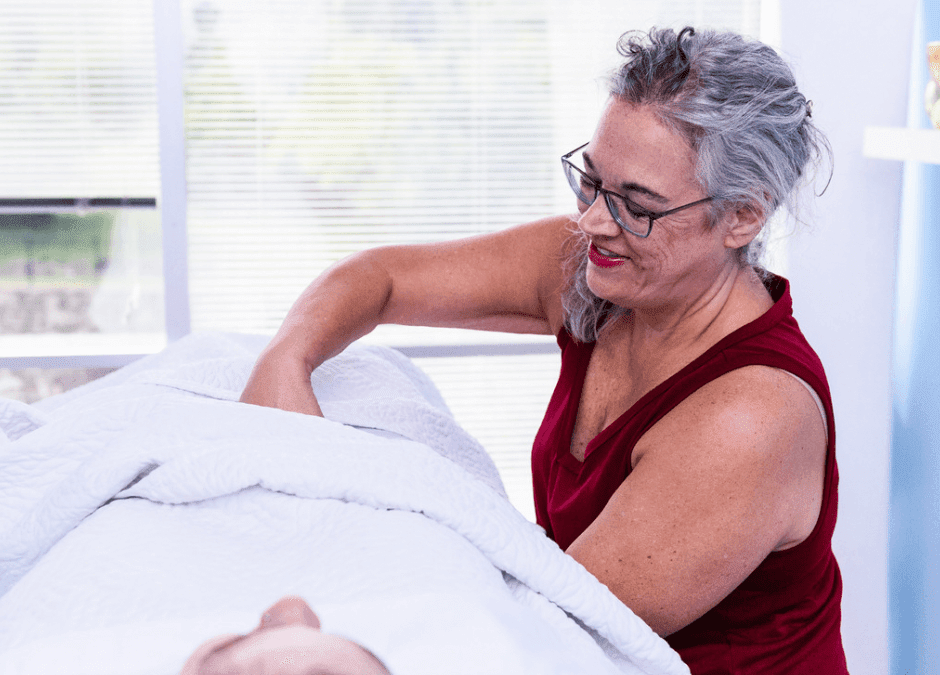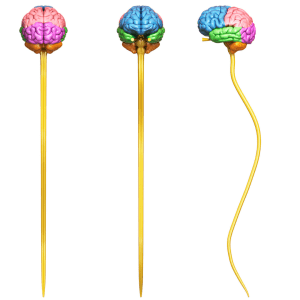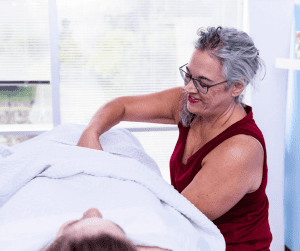Massage strongly impacts the nervous system which, in turn, helps dictate our overall wellbeing.
Recently, a new client came in and began telling her story of six months of chronic upper body pain, muscle spasms, periodic tingling in her hands plus lack of sleep and more. In her opinion, her medical doctor had failed to help. Numerous tests failed to show anything specific, and therefore, she did not get any diagnosis. She emphatically told me it wasn’t all in her head. Sadly, this happens all too often. SHE ASKED, “DO YOU THINK YOU CAN HELP ME?” MY ANSWER WAS, “YES, I AM CONFIDENT IN THAT.”
Before going into the details of why I was so confident,
let me delve into one of the major, most complex, systems of the body – the nervous system.
THE NERVOUS SYSTEM IS TYPICALLY THOUGH OF TWO MAIN COMPONENTS:
- The central nervous system (CNS) which includes the brain and the spinal cord
- The peripheral nervous system (PNS) which encompasses the nerves that extend throughout the body – thus connecting the CNS to various organs, tissues and sensory receptors
The nervous system regulates and coordinates countless activities, and it facilitates communication between the different parts of the body which, in turn, allow for sensory perception, motor control and cognitive functions. Neurons (or nerve cells) transmit action potentials (or electrical impulses) enabling fast and clear communication throughout the body.
When a person is in pain, experiences profound or chronic stress, lacks mobility or balance or even just has trouble sleeping…
something is amiss within a part of the nervous system.
Our wellbeing is highly dependent on the proper functioning of this system, ranging from its most simple reflexes to the most complex of processes.
In addition, one of the most remarkable aspects of the nervous system is its innate ability to adapt and change. The term “neuroplasticity” refers to the brain’s capacity to reorganize and rewire itself in response to new experiences, learning, and/or recovering from injury. In addition, two other subsets of this system – the sympathetic and parasympathetic divisions – govern the “fight or flight or freeze” response.
What does all of this have to do with helping the client?
EVERYTHING!
Now, in truth, I could not promise my work would make her pain go away or even lessen.
I could not tell her she would sleep better or have any better range of motion.
 What I did tell her is that–
What I did tell her is that–
When you have pain – be it chronic, acute or passively annoying on occasion – massage can help with a number of things.
CHECK OUT SOME OF THE WAYS MASSAGE HELPED HER:
-
REDUCES STRESS! Being in pain is stressful. Sometimes, just knowing we are doing something to take care of our body is often enough to help shift the internal messages we silently give ourselves about the pain we are experiencing.
-
REDUCES INFLAMMATION & SWELLING! Pain typically implies that inflammation and/or swelling exists. Massage helps move it out of the area, offering a noticeable reprieve from the pain.
-
IMPROVES CIRCULATION! Not having enough blood, lymph, oxygen and nutrients to the muscles and tissues causes stiffness – while improving circulation reduces pain, eases stress and improves mobility.
-
HELPS ORGANS FUNCTION PROPERLY! Abdominal massage and other techniques are instrumental in stimulating the organs. When we are under stress, so too, are our organs.
Massage therapy has techniques within its scope of practice that help to either awaken or calm the nervous system–both of which will help it – and the rest of our body to – FUNCTION BETTER!
Because the client was worried nothing would help her and that fear seemed like a heavier burden than her pain in the moment:
- I began with a technique designed to calm the nervous system.
- I then continued with craniosacral therapy which specifically addresses the interstitial fluid that travels between the brain and spinal cord,
- and then, I addressed the entire upper body–blending Swedish massage with Trigger Point Therapy and some passive stretching, she couldn’t believe how much better she felt after the first session.
One of the biggest and best parts of my job is to gently remind the client that his/her/their amazing body has the ability to self-correct, though sometimes we need the aid of a therapist to help us remember.
After several sessions, the client said her pain was gone. She was back to working out and her sleep-pattern was back on track.
A diagnosis, or lack thereof, was no longer her focus. Massage was able to help break a pattern of pain and concern. If you’d like to see how massage can help you with your pain or stress, call today to schedule your next session!
Libby Winterhalter, founder of Advanced Massage Services, is a licensed massage therapist and has been in private practice since 2004. Graduating from SHI Integrative Medical Massage School, Libby is licensed with the State Medical Board of Ohio.


 Recently, a new client came in and began telling her story of six months of chronic upper body pain, muscle spasms, periodic tingling in her hands plus lack of sleep and more. In her opinion, her medical doctor had failed to help. Numerous tests failed to show anything specific, and therefore, she did not get any diagnosis. She emphatically told me it wasn’t all in her head. Sadly, this happens all too often. SHE ASKED, “DO YOU THINK YOU CAN HELP ME?” MY ANSWER WAS, “YES, I AM CONFIDENT IN THAT.”
Recently, a new client came in and began telling her story of six months of chronic upper body pain, muscle spasms, periodic tingling in her hands plus lack of sleep and more. In her opinion, her medical doctor had failed to help. Numerous tests failed to show anything specific, and therefore, she did not get any diagnosis. She emphatically told me it wasn’t all in her head. Sadly, this happens all too often. SHE ASKED, “DO YOU THINK YOU CAN HELP ME?” MY ANSWER WAS, “YES, I AM CONFIDENT IN THAT.”
 What I did tell her is that–
What I did tell her is that–